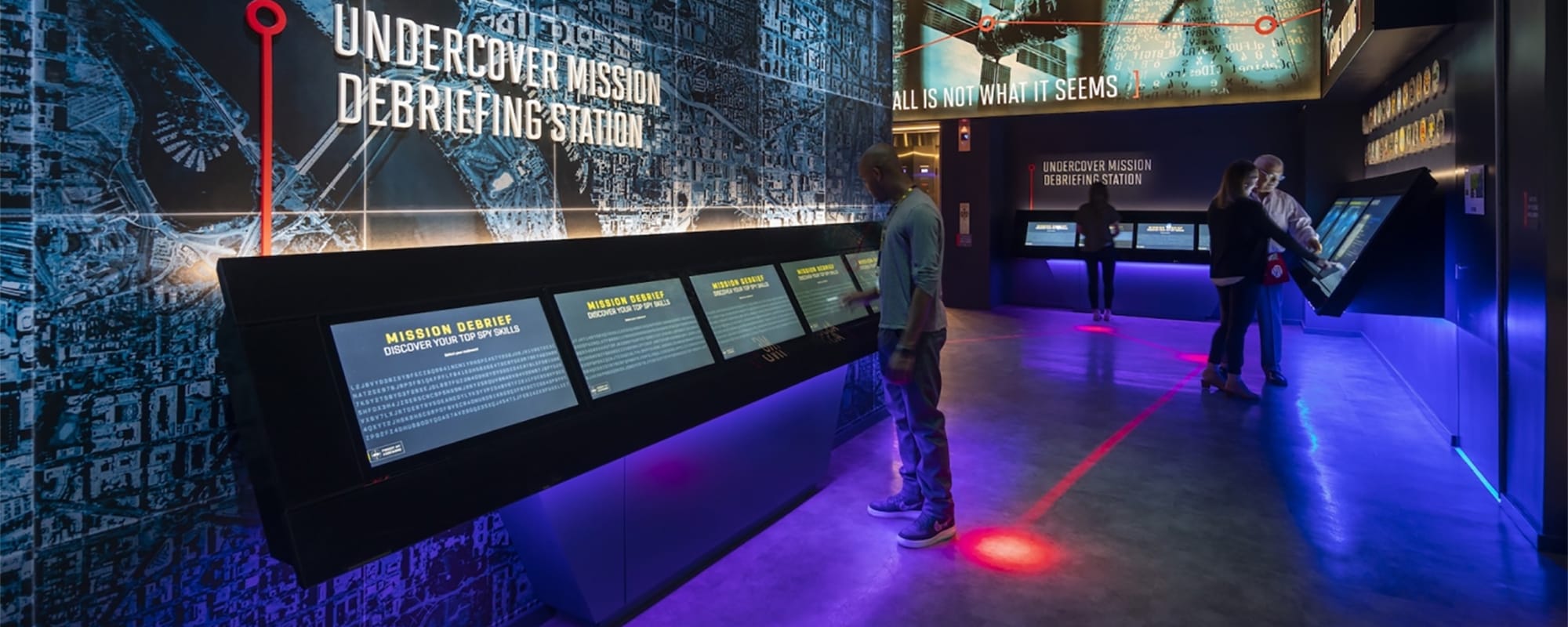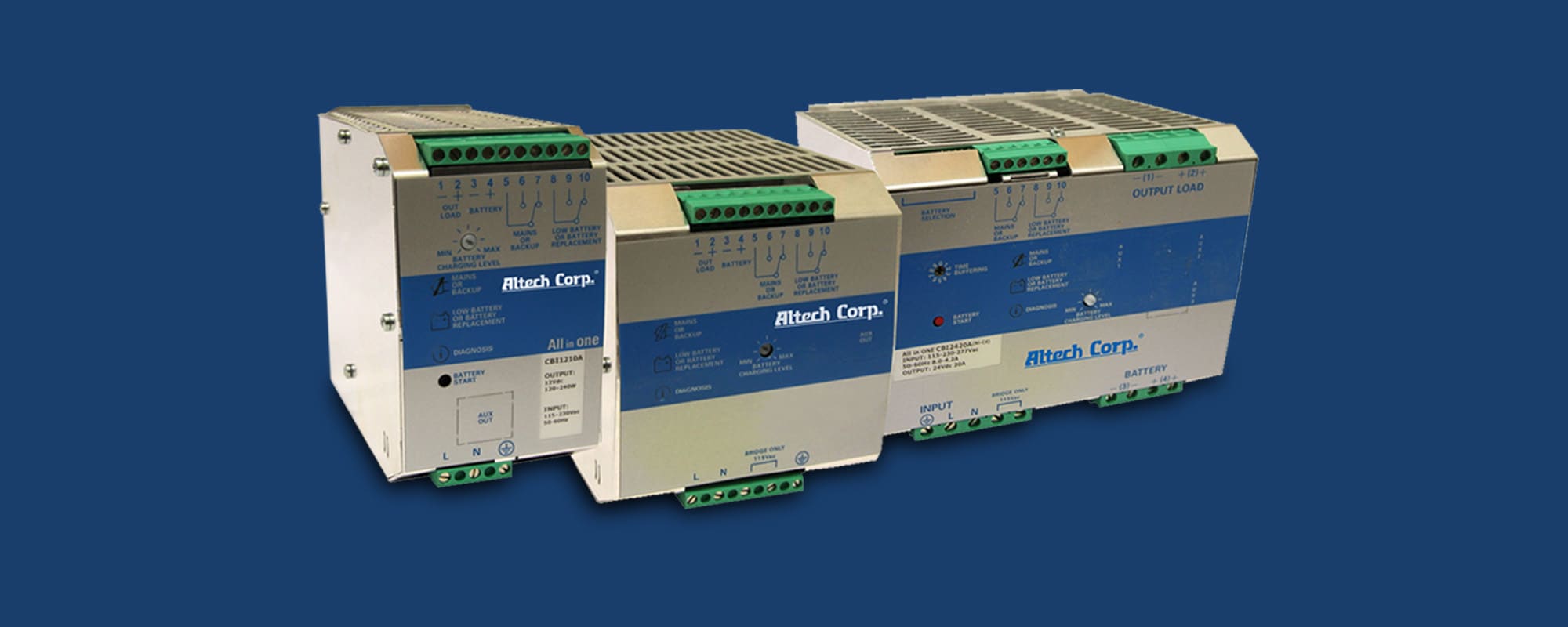IO-Link is the world’s fastest growing sensor and actuator interface — and for good reason. This open standard serial protocol allows you to unlock valuable data from sensors and devices and can help reduce production costs, increase process efficiency, and improve machine availability in industrial manufacturing applications.

The IO-Link communications protocol is way more popular now than when it was standardized in 2006. In fact, it’s currently the fastest growing sensor and actuator interface in the world due to its simple, fieldbus-agnostic master/device architecture and its reputation for enabling easy wiring, high compatibility, high functionality, and easy and cost-effective wiring.
In 2013, there were less than two million IO-Link nodes. Today, there are over 28 million, and the IO-Link Consortium has grown to include more than 400 key user companies and leading global automation suppliers, including Banner Engineering.
To learn more about IO-Link, we spoke with Sean Foley, a Global Product Manager at Banner Engineering.
Hi Sean. Please tell us a little bit about yourself. How did you come to work at Banner, how long have you been there, and what do you do in your current role?
I’ve always loved learning about math and science. I earned a degree in mechanical engineering from the University of Minnesota. When I graduated, I didn’t know that I was going to go into industrial automation, but I got an internship and I fell in love with the world of industrial automation. I started my career at an industrial automation company in Minnesota that specialized in sensor connectivity and fieldbus technology and spent several years there working in application engineering, marketing, training, and product management. I love learning, educating customers about industrial automation technology, and providing technical consulting services. It really became a passion, and that’s part of what brought me to Banner.
I joined Banner in 2021 as a global product manager and have been focused on IO-Link technology and the new Snap Signal IIoT product line, which offers a range of modular, plug-and-play hardware and software solutions that collect and distribute actionable machine data from legacy equipment. Both of these solutions allow operators to accurately and remotely monitor their facilities and make better data-driven decisions. I’m delighted to be a part of the Banner team. We develop high-quality, cutting-edge products that help our customers in the IIoT and automation space meet their efficiency, productivity, and profitability goals. It’s fantastic to be here.
Can you provide us with an introduction to the IO-Link protocol and its application in industrial manufacturing processes?
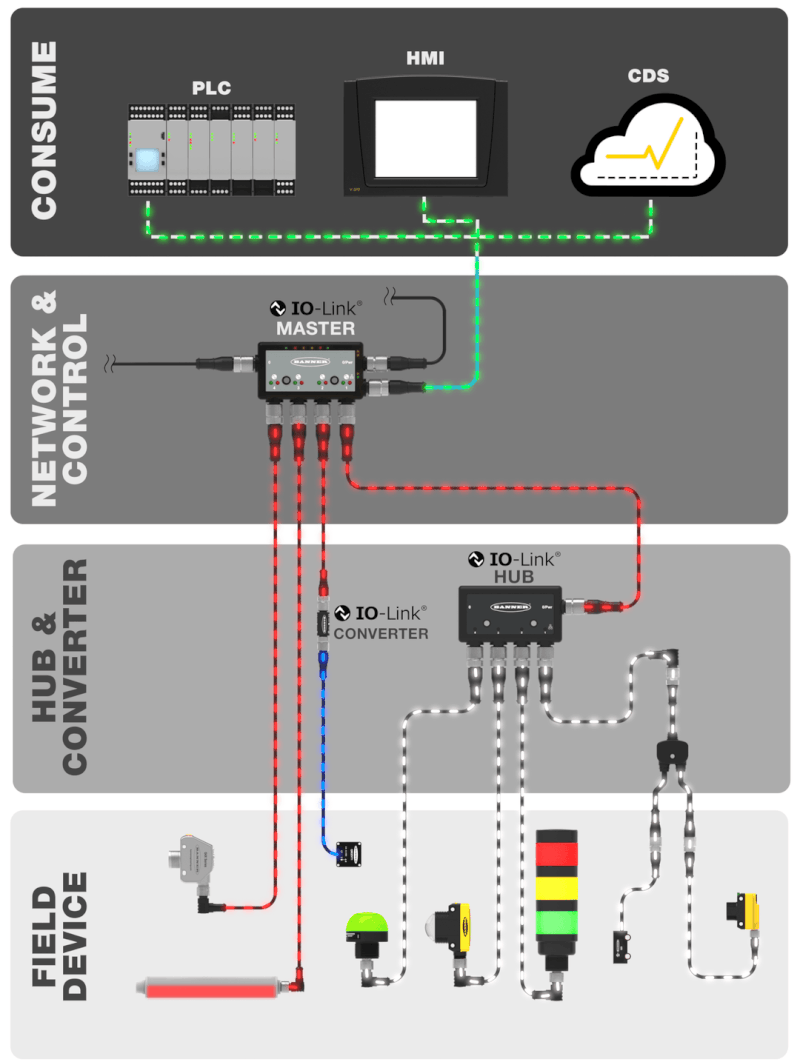
IO-Link is an open standard serial communication protocol that allows for the bi-directional exchange of data from compatible sensors and devices connected to an IO-Link master. IO-Link masters can transmit data over various networks, fieldbuses, or backplane buses, and make data accessible for both immediate action and long-term analysis via industrial information systems like PLCs and HMIs. IO-Link devices reduce wiring, increase data availability, enable remote configuration and monitoring, simplify device replacement, and provide extended diagnostics. So, they are especially well suited for IIoT applications.
Data drives the IIoT. As production demands increase, factories turn to real-time data to make smarter decisions. IO-Link devices tell you what they’re doing and how well they’re doing it and can instantly alert you to problems. They allow you to gain insight into and control over your sensors, get more out of your devices, and make better, data-driven decisions.
The capabilities afforded by IO-Link reduce costs, increase process efficiency, and improve machine availability. These benefits are especially significant in applications that have frequent changeovers and are heavily influenced by extended and unplanned machine downtime. For example, you can use IO-Link to increase productivity on an injection molding machine, measure throughput and overall equipment effectiveness on a case sealer, and remotely monitor hydraulic power units or tank levels.
The application of IO-Link technologies is growing exponentially. There are tens of millions of active IO-Link devices at present, and that’s expected to grow more than 20% year over year for the next several years.
One of the biggest advantages of IO-Link is the cost savings it offers in terms of connectivity and quicker installation time. I remember a recent conversation I had with an OEM who switched from a traditional IO system to an IO-Link system. With a traditional IO system, you have a centralized control cabinet, and all of your wires from all over your plant lead back to that. So, this OEM who built big, complex, machines had thousands of wires going back to this large control cabinet from all the sensors and actuators on his machines. And when he switched to IO-Link, he went from having thousands of wires going back to his main control cabinet to having just six Ethernet cables, which offered significant savings in terms of wiring.
Imagine having to land every individual wire to your PLC in your control cabinet for every sensor. IO-Link is typically standardized on M12 connectivity, and you can just have an Ethernet cable going back to your PLC. So, the cost savings on wiring — and not just for hardware but for installation and maintenance times — is a huge advantage. I’ve seen OEMs achieve 15–20% savings on both hardware and installation costs when going from a standard IO system to IO-Link.
While there is an upfront investment when you’re going from a traditional IO system to IO-Link — for instance, changing cord sets from more standard wire-based connections to M12 connectivity — switching typically pays for itself very, very rapidly.
The exponential growth of IO-Link technology is really driven by interoperability. There’s currently around 400 members of the IO-Link Consortium. These sensor, PLC, valve, and actuator manufacturers came up with a unified communication protocol to ensure interoperability between IO-Link devices. This means that any IO-Link device will work with any IO-Link master. Because, while we’ve talked about IO-Link in the manufacturing industry, there’s all these IO-Link devices that are geared towards specific applications in the automotive and oil & gas and pharmaceutical markets, for example. And because of the Consortium, they will all work with any IO-Link master.
I understand that IO-Link technology offers numerous benefits. How does it outperform competing technologies?
IO-Link is a vendor independent and interoperable technology, and that’s extremely useful for implementing IIoT networks. By adopting IO-link devices, you can benefit from a whole host of powerful advantages.
One of the biggest is simple, cost-effective connectivity. IO-Link devices can quickly, easily, and seamlessly replace analog sensors and devices, eliminating the need for high-resolution analog inputs cards and expensive shielded cables and reducing the number of sensor interfaces required, which reduces inventory costs. They also use cost-effective standardized three-pin M12 cables with universal connectors instead of the bulky homerun connectors often used to connect analog sensors to higher level control systems. This maximizes efficiency, reduces wiring time, cost, and complexity, and helps eliminate wiring and pinout mistakes.
And you can typically achieve these benefits even if you don’t have an IO-Link device because Banner offers IO-Link converters that are about the size of a AA battery and can convert legacy signals to IO-Link. So, even if you have legacy sensors geared towards a specific application that you really need to use, for instance, you can still standardize to IO-Link without issue.
Another major benefit is convenient control. Remote configuration and monitoring capabilities allow you to dynamically control devices and easily switch between device parameters to speed up product changeover and accommodate a greater variety of products.

Smarter communication is a key benefit as well. IO-link gives you access to detailed operational and performance data for your devices. Smart sensors with IO-Link allow you to remotely access sensor readings to see how well they’re doing. IO-Link devices collect and deliver real-time data that lets you diagnose problems before they escalate, calculate equipment effectiveness, identify performance trends, and optimize maintenance schedules. Real-time sensor data also makes troubleshooting simple, and historical data helps predict and prevent future downtime.
IO-Link also enables quick and easy device replacements and system expansions. With IO-Link, you can store sensor configurations on your IO-Link master. So, if you need to replace a sensor, you can simply swap it out for a new one — and it and the IO-Link master can automatically import the previous device’s settings to help you get your line back up and running as quickly as possible.
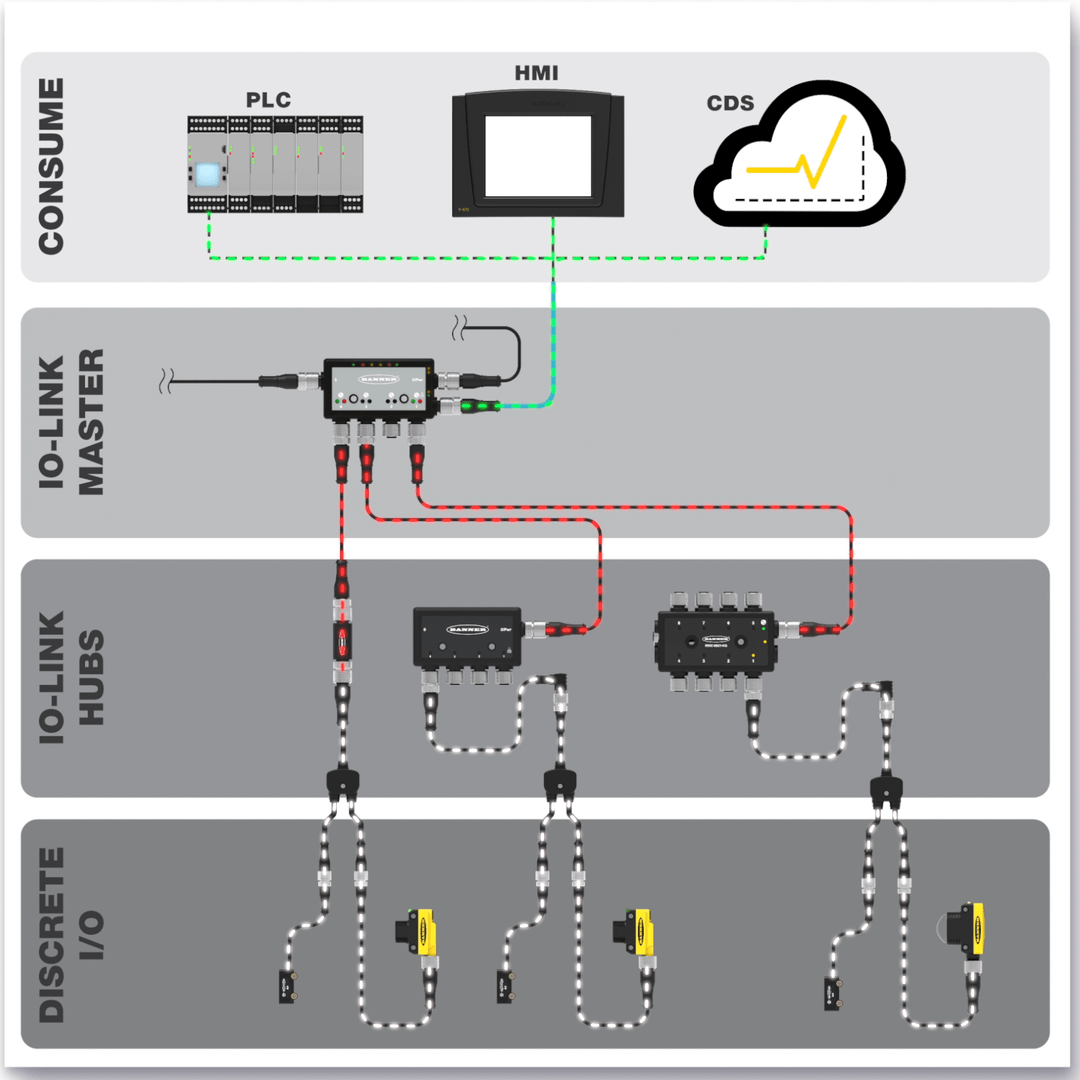
Each master can communicate with a certain number of sensors, but you can expand your IO offering with additional Modbus RTU IO-Link masters and link them all together in a network. There are a few different versions. There are IO-Link masters with multiprotocol Ethernet communications directly on the master as well as IO-Link masters with Modbus RTU communications. With the Modbus RTU interface, you can actually daisy chain, or essentially network, multiple masters together, have one branch going back to a controller, and then from there, communicate Ethernet back to a PLC. So, we’ve seen Modbus RTU masters used as an excellent option for bringing large quantities of IO-Link sensor data back to a PLC simply because it allows you to network multiple IO-Link masters on one branch going back to a controller.
IO-Link is also an excellent method of transmitting large quantities of discrete IO to a higher-level control system using IO-Link hubs. IO-Link hubs allow you transmit signal from multiple discrete NPN of PNP sensors back to an IO-Link master via a standard three-pin cordset.
Are there any perceived disadvantages of IO-Link technology that you’d like to dispel? Are there any real but surmountable challenges to adopting this technology?
Some people think that limited compatibility is an issue. But thanks to the IO-Link Consortium, there are tens of millions of interoperable IO-Link devices, and there are IO-Link converters for incompatible legacy devices.

Another perceived disadvantage is complexity. Some people think that integrating and installing IO-Link technology is difficult, and sure there’s a learning curve, but investing the time to learn about the technology and set it up correctly is well worth it, and you’ll actually find that things like device replacement and troubleshooting are much easier with IO-Link.
Cost can be a perceived disadvantage too. But while you may need to invest in some new hardware, the significant hardware, installation, and maintenance cost savings that switching to IO-Link offers rapidly outpace the initial investment.
What are the primary components of an IO-Link system? If I wanted to adopt this technology in my manufacturing facility but wanted to start slow, what would I need? What do each of these key components do?
You only need a couple of components to get your IO-Link system up and running. You need an IO-Link device, like a sensor, or a light, or an actuator. You need an IO-Link master, which transmits data over various networks, fieldbuses, or backplane buses, makes that data accessible for immediate action or long-term analysis via PLC, HMI, SCADA, or cloud platform to give users more information about their devices, and enables the remote monitoring of machine performance. And you need a cable between them. The cable length in an IO-Link system has a maximum length of 20 meters, which is important to note. A unique and powerful benefit of IO-Link devices is that you don’t need any specialized cable. These systems typically use standard, readily available and economical three-wire M12 cables.
If you want to adopt this technology in your manufacturing facility but want to start slow and get comfortable with the technology before you go all-in, I’d recommend getting an IO-Link master like the Banner DXMR90-4K, an IO-Link sensor, an M12 cable between the IO-Link master and sensor, a power supply, and an Ethernet cable. Set this up, connect it to your laptop or PC, learn how you can configure your sensors, learn how you can connect it to your PLC, and start to see how you can scale up and add new devices. Then, check out what you can do with some of the advanced diagnostics, and start seeing the big picture of how you can integrate it and convert your system over to an IO-Link platform. I usually recommend starting small, thinking big, and scaling fast with an IO-Link system.

What kind of technologies could I employ if I wanted to go all-in on IO-Link in my manufacturing facility, and how easy would it be to make the switch?
There are tens of millions of IO-Link devices, including photoelectric, fiber optic, and measurement sensors, strip lights and tower lights, touch buttons and indicators, actuators, valve banks, and more. So, what you need will really depend on your application. Many manufacturers already have IO-Link onboard at least some of their devices and just aren’t using it, and if that’s the case, they just need to make the switch to using IO-Link masters, which makes for an exceptionally easy switch. But even if that’s not the case, switching is still pretty easy due to the limited core component requirements, vast interoperability, and quick payoff.
You might also want IO-Link hubs to complete your installation. These devices allow you to connect large numbers of discrete sensors and actuators to an IO-Link Master via standard M12 cables and send that signal data to PLCs, HMIs, SCADAs, or cloud networks to generate productivity-boosting data analytics.
In addition, if you have legacy devices that you want to connect to your IO-Link system, you’ll need IO-Link converters, which convert various types of signals — such as discrete, analog, and others — to IO-Link signals.
Are there any physical or electrical characteristics that new adopters should be sure to look out for and preference as they’re identifying IO-Link solutions?
Small form factors are one and can be especially critical for IO-Link masters installed on applications like robotic arms or robotic weld cells, where weight and real estate can quickly become an issue. Ruggedness is another big one. Since there are so many millions of IO-Link devices out there, many of them have to ruggedly withstand a variety of harsh environment conditions ranging from extreme temperatures to water and chemical exposure, high humidity, salt spray, and even weld splatter.
Does Banner Engineering’s line of IO-Link solutions offer any unique features and benefits that customers won’t find elsewhere?
While all IO-Link products are interoperable, individual manufacturers still offer unique advantages. For example, Banner’s IO-Link masters and hubs have a unique form factor in that our connectors come out of the sides instead of the top. So, you typically don’t have to worry about the M12 cable bend radius, which is often an issue with IO-Link masters with the connectors on top. Our IO-Link masters and hubs are also available with mounting brackets that support stackable configurations for space savings and efficiency, and they both offer their own unique benefits as well.

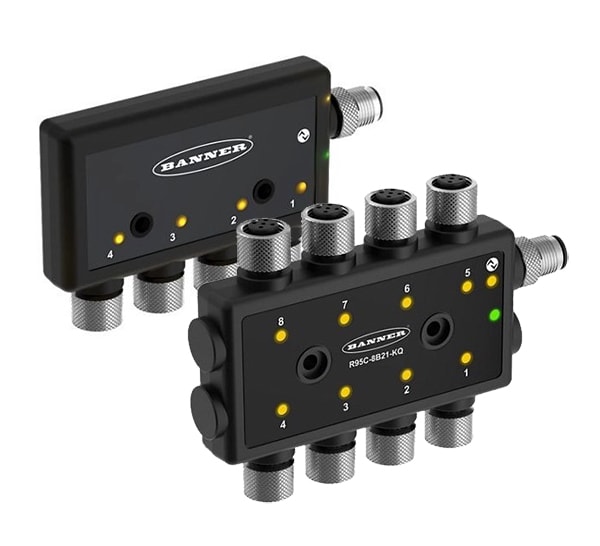
For example, our IO-Link masters are multiprotocol, so they can support Ethernet IP, Modbus TCP, and PROFINET, and they can also deliver data directly to the Banner Cloud. Not a lot of other IO-Link masters have that capability. Most of them have to route data through another device to deliver it to the cloud. Our DXMR90-4K IO-Link masters can also operate as a standalone controller. So, they offer both functionality and logic via read/write rules or script basic, which is really a game changer since it can allow you to operate without the need for a PLC in certain applications. If you have a simple application, maybe you don’t need to buy a very expensive PLC and, instead, can leverage the controller capabilities of your IO-Link master. We’ve also got serial IO-Link masters that allow you to trunk and branch multiple paths on a Modbus RTU or RS45 network. This allows you to bring in lots of IO-Link data, which allows you to do a lot of very interesting things. You can also connect our serial IO-Link masters to our serial radios and have your IO-Link data transmitted wirelessly across your factory.
Our IO-Link hubs have a really powerful and uniquely advanced feature as well. They can support smart logic directly in the hub, which is something that’s totally unique in the market. They can do on-delays, off-delays, port mirroring, and one-shot modes, which essentially allows you to have almost a standalone smart relay as part of your IO-Link hub. Most IO-Link hubs on the market are passive; they just bring discrete IO-Link signals into their IO-Link master.
In addition, our line of compact converters, most of which are about the size of a AA battery, can convert standard industrial signals to IO-Link and transmit it to an IO-Link master, allowing you to easily integrate legacy devices into your IO-Link system.
We also offer the compact R70SR serial data radio to extend the range of serial communications networks. This low-power wireless communication device allows you to wirelessly send data to the from one of Banner’s serial IO-Link masters.

Industry 4.0 has had an enormous impact on the industrial manufacturing industry in recent years. How have related trends and developments influenced the adoption, deployment, and/or design of IO-Link technologies?
The anticipated continuous growth of the IO-Link market is driven by the evolution of Industry 4.0, the interoperability of IO-Link technologies, regardless of supplier, and the increasingly vital role that data plays in industrial applications. As time goes on, engineers will find new ways to design IO-Link masters and link more equipment. I also think that IO-Link devices that can connect directly to a cloud platform as well as PLCs and HMIs, like ours, will become more important. IO-Link has traditionally been used in control systems, but I think it’s going to be used in more data collection applications going forward and that we’re going to see cases where it’s almost separate from the controller, monitoring critical assets for predictive maintenance.
What do you think is next in terms of IO-Link device designs and performance?
I think many more manufacturers will join the consortium and that adoption of IO-Link will continue to skyrocket. In terms of device designs and performance, I think the next few years could see improved communications speeds and the ability to interface with more input and output devices. Additionally, AI and machine learning algorithms in IO-Link designs could enable things like more accurate data transfer between machinery and other systems and eventually lead to more precise and efficient automation processes. In terms of applications, I expect to see an uptick in using IO-Link devices for data collection, condition monitoring, and preventative maintenance.
Is there anything else you’d like industrial OEMs and system integrators to know about IO-Link?
Switching over to IO-Link, which is standardized on M12 connectivity, makes things much easier for OEMs, especially in terms of installation time and speed. For example, aftermarket services are a really big revenue generator for OEMs. A lot of them provide a piece of equipment as well as aftermarket services to replace components and devices like sensors. IO-Link makes replacements like these seamless, and with data storage mode or back and restore mode, you don’t even have to reconfigure the replacement sensors, which saves labor as well — and not just in terms of installation time. Since IO-Link devices are so easy to install and support remote access, OEMs may not even have to go out to service the machine. Instead, they could just send a replacement part, or have the customer install from inventory, and then remotely access and configure the replacement if necessary.
Standardizing on IO-Link and having IO-Link masters gathering data on machines also allows operators to remotely configure devices and access diagnostic data to gain insights into the functionality of connected equipment. These condition monitoring capabilities make troubleshooting easier and allow operators to enact preventative maintenance measures. Another benefit to standardizing on IO-Link is that it allows OEMs to shrink their control cabinets because they only have Ethernet cables going back to the cabinet and their PLCs.
Unlock Your Sensor Data and Upgrade Your Facility With IO-Link
Banner Engineering has more than 55 years’ experience designing and developing products engineered to increase the productivity and operational efficiency of industrial automation processes. Its extensive product portfolio includes more than 10,000 sensor, switch, LED lighting and indication, wire & cable, industrial data communications, industrial control, and connector solutions built for easy installation, reliable operation, and high performance.
RS offers a wide range of Banner Engineering products for industrial manufacturing applications, including its line of IO-Link solutions. Stocked solutions include IO-Link masters, hubs, and sensors, lighting and indication, safety switches, and data converters.
For more information about Banner’s IO-Link technologies, please visit its IO-Link product page. For assistance identifying, deploying, and maintaining Banner Engineering IO-Link solutions that deliver simple, cost-effective connectivity, convenient control, and smarter communications sure to improve the efficiency and productivity of your industrial automation processes, please contact an RS sales representatives at 1.866.433.5722 or reach out to its technical support team.


